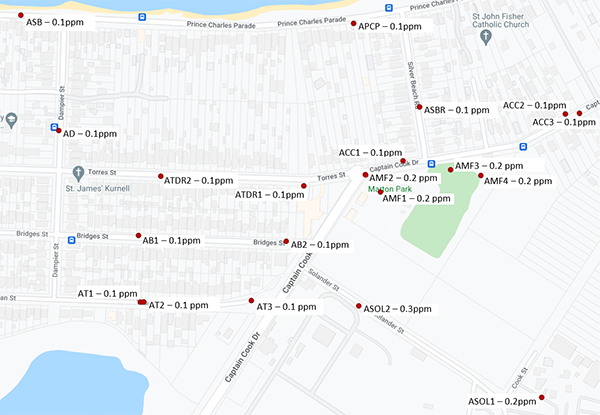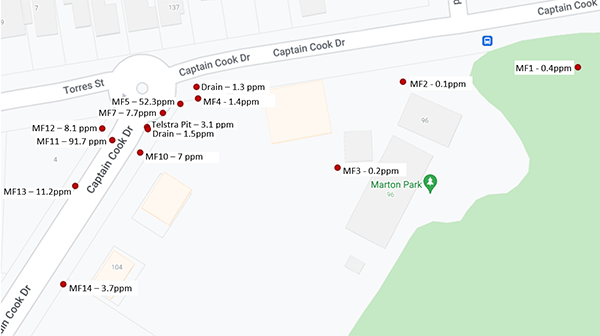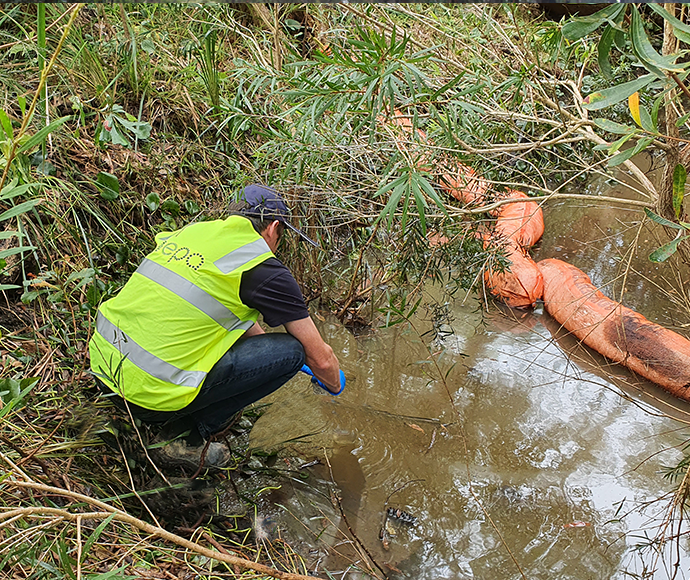Early on Thursday 7 April, some parts of the Kurnell area were affected by an overflow of oily wastewater from the treatment plant at Ampol’s terminal which spilled onto Captain Cook Drive and surrounding areas.
What the EPA is doing
Our officers have been in the area inspecting the potential damage and supervising Ampol’s clean up.
Since the incident we have
- Issued Ampol with a legally binding clean-up notice requiring it to properly clean up the oily wastewater and impacted areas as quickly as possible.
- Instructed Ampol to bring in an independent environmental consultant to assess the extent of impacts on the environment. This includes sampling the water and soil.
- Reviewed Ampol’s initial sampling results
- Performed our own sampling of soil and water in the area following the spill to gauge the contamination level.
- Remained onsite to regularly inspect the clean-up process to ensure it meets our requirements.
- Our officers are continuing to sample at Silver Beach, Marton Park, Taren Point wetlands and Quibray Bay.
- Actively engaged with the community by responding to their reports, delivering information through letterbox drops, and attending community meetings.
- Conducted testing of samples from residents’ bores
- Sought approvals from utilities including Telstra, NBN, Jemena and Sydney Water to allow Ampol to proceed with the clean-up
We are working with other agencies including National Parks and Wildlife Service to ensure wildlife and habitat in and around Ramsar wetland is monitored. Our officers, wildlife carer groups and National Parks officers have been out inspecting the wetlands.
The EPA’s role
Our role as the environmental regulator is to
- provide specialist advice to Fire and Rescue – who are usually the first responders for an incident like this
- ensure that any immediate preventative measures are taken as quickly as possible to stop a spill spreading
- direct the polluter (Ampol) to properly clean-up, and monitor progress
- investigate the incident, to see if any regulatory action should be taken against the polluter
Investigation and regulatory action
We are investigating the incident at Kurnell and will consider regulatory action if breaches of the environment protection legislation are found.
Pollution Reduction Program
The EPA sampled the water in the Kurnell wharf stormwater drain at Silver Beach in April which detected fuel residues above water quality guidelines. In response to these results and community concern we have amended Ampol’s environment protection licence, requiring Ampol to undertake a comprehensive assessment of the stormwater drain through a Pollution Reduction Program.
This requires Ampol to engage an independent expert to undertake routine monitoring of discharges from the drain as well as air monitoring over a three-month period.
Ampol must submit a report to the EPA detailing the results, including consideration of community observations, and proposed next steps.
The Pollution Reduction Program is legally binding and will help to identify any impacts to the water quality in the drain and potential measures to ensure the beach water quality is not being impacted in the long term.
Sampling data
Ampol has released data from samples taken immediately after the overflow. This can be found on their website.
The samples are from Silver Beach, Marton Park and the wetlands at Marton Park and Quibray Bay.
Ampol’s water samples were taken on the days immediately after the event before the polluted water was removed. The results generally show fuel products in areas along Captain Cook Drive and in Marton Park. Benzene levels were below detection for all samples. Polluted water has now been removed and disposed of appropriately.
The EPA has also undertaken soil and water sampling.
The EPA’s soil samples were taken on 19 April at Marton Park Oval when the areas were free of standing water. The samples did not contain any detectable levels of oil or fuels.
We undertook water sampling on 19 April at the Kurnell wharf stormwater drain which detected fuel residues above water quality guidelines.
Further investigation of the wharf stormwater drain by Ampol is required under the Pollution Reduction Program.
We also undertook follow up sampling at multiple locations along Silver Beach on 22 April which did not detect fuel related pollutants. Samples from waterways on Marton Park (MPUS on map) on 19 April detected fuel residues above water quality guidelines. These water quality guidelines are long term objectives. The ongoing removal of fuel from waterways in Marton Park and other areas should result in an improvement in water quality.
We monitored the air quality around Kurnell on 22 April 2022 using a photoionisation device (PID). The PID measures volatile organic compounds (VOCs) which are present in substances such as diesel.
We monitored the: ambient air and soil vapour. VOCs were not detected during the ambient air monitoring around Kurnell. Soil vapours from areas which were impacted by the incident on 7 April were monitored by putting soil into zip lock bags, allowing 10 minutes for volatiles to accumulate and then reading the air in the bag with the PID. 12 out of 14 soil samples detected VOCs. This was expected as these areas where soil vapour monitoring was undertaken had yet to be cleaned up by Ampol.
The clean-up of impacted grass and soil should result in a continued improvement of odours at Kurnell.
Questions and answers
Are there any potential health risks associated with exposure to high quantities of diesel and other petroleum oils?
NSW Health has provided the following advice
- The most likely route of exposure is breathing in the associated fumes, so where possible avoid being in areas where fumes are high. Brief exposures (minutes to hours) in outdoor spaces are unlikely to have a health impact. Continuous exposure to fumes should be avoided. Headaches, eye or airway irritation may follow exposure. However, once the exposure stops, it is expected that these acute health effects will resolve.
- If the smell is outside, keep windows and doors closed to limit exposure indoors.
- If diesel and other petroleum oils contact skin or clothing and remain there for several hours it may absorb into the skin and cause inflammation, cracking or peeling skin. If you get oily water on yourself, promptly wash it off with soap and water and change clothes.
Can I drink tap water?
- Sydney Water has advised its drinking water is safe to drink and has not been impacted by the spill.
- NSW Health advises that bore water should not be used for drinking, especially if it smells of diesel or oil.
- If you have concerns with your drinking water or wastewater system you can call Sydney Water on its 24-hour emergency hotline 13 20 90.
Can I eat vegetables grown in my backyard?
- NSW Health advises that if the vegetables are thoroughly washed with drinking water and there is no residual oily smell after washing the vegetables, they may be eaten.
Can I water my lawns, wash my car, or fill my pool?
- It is safe to water the garden, wash your car or fill a pool using Sydney Water supplied drinking water. If you use a private bore, do not use it for any of these purposes if you can smell diesel or oil.
I have contamination in my garden what do I do?
- Avoid contact with any oily water. Do not enter the affected area and keep family and pets away until the clean-up is complete.
- Contact Ampol’s hotline 1800 719 669 to report any impacts to your property or to find out information about their clean-up activities.
Can I go swimming?
- It is important not to swim in water impacted by an oil spill due to the health risks of ingestion and skin contact. Do not swim if there is any visible oil in the water.
- The EPA has inspected Silver Beach several times since the incident and has not seen any indications of contamination.
- The Department of Planning and Environment’s Beachwatch program recommends avoiding swimming during and for up to three days after rainfall at estuarine swimming locations, or if there are signs of stormwater pollution such as discoloured water, flowing drains, odours or debris.
Can I go fishing and eat the fish?
- There have been no changes to recreational fishing arrangements in Botany Bay from the NSW Department of Primary Industries – Fisheries.
- The NSW Food Authority strongly advises against anyone consuming seafood if they don’t know where it’s come from. Like all fresh food from animals, seafood needs to be handled well to minimise the risk of food poisoning. See these important tips for recreationally caught or collected seafood.
Can I take my pets to the beach?
- Pets should not enter water impacted by an oil spill for the same reasons that people should not swim in the water.
- Do not allow your pets to swim if there is any visible oil in the water.
My smoke alarm went off, is it related to the incident?
- Fire & Rescue NSW has advised that fuel vapours or odours would not trigger a response from a residential smoke alarm.
Can I use my bore water?
- NSW Health advises that bore water should not be used for drinking, especially if it smells of diesel or oil.
Who can I contact for help?
- Call the Ampol community hotline 1800 719 669. 24hrs/7days about the clean-up.
- Report wildlife affected by oil to National Parks and Wildlife Service on 1300 072 757 or Taronga Wildlife Hospital on 02 9978 4785 or read further information.
- Affected wildlife in the Towra Point Nature Reserve should be reported to National Parks and Wildlife Service on 1300 072 757.
- Contact Environment Line on 131 555 or info@epa.nsw.gov.au.




